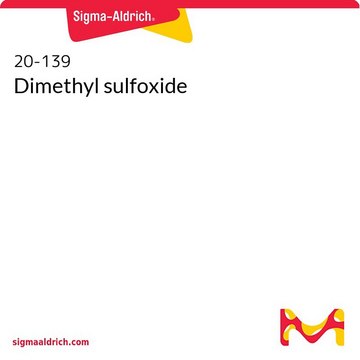D1435
Dimethylsulfoxid
meets EP testing specifications, meets USP testing specifications
Synonym(e):
DMSO, Methylsulfoxid
About This Item
Empfohlene Produkte
Agentur
meets EP testing specifications
meets USP testing specifications
Qualitätsniveau
Dampfdichte
2.7 (vs air)
Dampfdruck
0.42 mmHg ( 20 °C)
Assay
≥99.5%
Form
liquid
Selbstzündungstemp.
573 °F
Expl.-Gr.
42 %, 63 °F
Methode(n)
cryopreservation: suitable
Verunreinigungen
≤0.1% water (Karl Fischer, USP)
≤0.2% water (Karl Fischer, EP)
Farbe
colorless
Brechungsindex
n20/D 1.478-1.479
n20/D 1.479 (lit.)
bp
189 °C (lit.)
mp (Schmelzpunkt)
16-19 °C (lit.)
Löslichkeit
H2O: miscible (completely)
Dichte
1.100-1.104 g/mL at 25 °C (relative density (EP))
1.10 g/mL (lit.)
UV-Absorption
λ: 285 nm Amax: ≤0.20
λ: 295 nm Amax: ≤0.20
SMILES String
CS(C)=O
InChI
1S/C2H6OS/c1-4(2)3/h1-2H3
InChIKey
IAZDPXIOMUYVGZ-UHFFFAOYSA-N
Suchen Sie nach ähnlichen Produkten? Aufrufen Leitfaden zum Produktvergleich
Anwendung
- for the dissolution of tetramethylrhodamine dye, which is used as fluorophore for fluorescence in- situ hybridization (FISH) experiments
- as a control in indirect immunofluorescent assay (IFA) of swine testicular (ST) cells
- for the suspension and separation of buccal cells
- a polar aprotic solvent used in polymerase chain reactions (PCR) and as a cryoprotectant vitrification agent for the preservation of cells, tissues and organs.
Biochem./physiol. Wirkung
Vorsicht
Sonstige Hinweise
Dimethyl Sulfoxide Miscibility/Immiscibility Table
Ähnliches Produkt
Lagerklassenschlüssel
10 - Combustible liquids
WGK
WGK 1
Flammpunkt (°F)
188.6 °F - closed cup
Flammpunkt (°C)
87 °C - closed cup
Persönliche Schutzausrüstung
Eyeshields, Gloves, type ABEK (EN14387) respirator filter
Hier finden Sie alle aktuellen Versionen:
Besitzen Sie dieses Produkt bereits?
In der Dokumentenbibliothek finden Sie die Dokumentation zu den Produkten, die Sie kürzlich erworben haben.
Kunden haben sich ebenfalls angesehen
Artikel
Hepatocytes are epithelial cells found in the liver. They perform important functions, such as helping to detoxify blood, and to synthesize transport proteins, such as lipoprotein, albumin and transferrin. Primary and secondary cultures of hepatocytes are useful for studying the mechanisms of liver regeneration and differentiation.
Unser Team von Wissenschaftlern verfügt über Erfahrung in allen Forschungsbereichen einschließlich Life Science, Materialwissenschaften, chemischer Synthese, Chromatographie, Analytik und vielen mehr..
Setzen Sie sich mit dem technischen Dienst in Verbindung.





